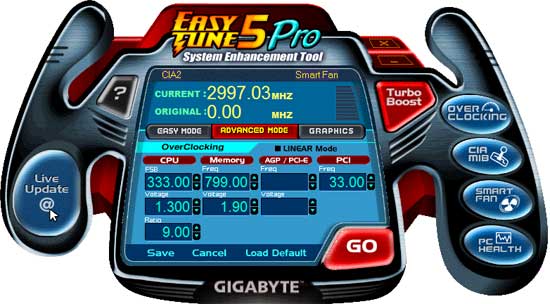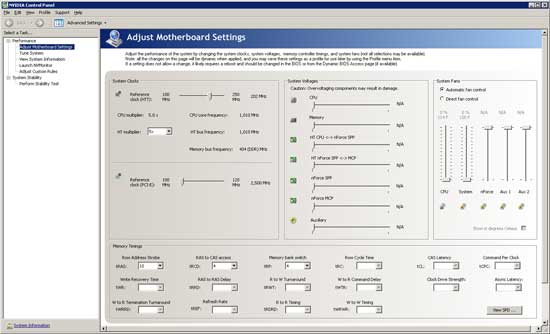Getting the Most Out Of Your Hardware: Motherboard/CPU Utility Roundup
by Ryan Smith on December 12, 2007 12:00 AM EST- Posted in
- Guides
Motherboard Tweaking Utilities
If we had to sum up the state of motherboard tweaking utilities in one word, that word would be dilapidated. Why that word? This is something that is easier to explain if we start with a screenshot.

The above is a screenshot of Gigabyte’s Easy Tune application running on a P35-DS3R motherboard. Because Intel does not provide a standardized method of motherboard tweaking, it falls to the motherboard manufacturers to try to shoehorn Intel’s chipsets in to offering this kind of functionality anyhow, via a high level of careful BIOS manipulation combined with their own software package. Many of the tier-1 motherboard manufacturers offer some kind of utility in this vein, so this isn’t us picking solely on Gigabyte; just about everyone is committing the same sins here.
Generally, the software provided by the motherboard manufacturers suffers from these problems:
- The GUI does not adhere to any sort of standards or guidelines
- The software works on only a fraction of the company’s motherboards, and you’ll never know quite which ones these are
- The software does not consistently function correctly, or does not produce results as good as those done via CMOS tweaking
To be fair, elements #2 and #3 are not completely in their control since much of this goes beyond the scope of what the chipset was intended to do in the first place. But never the less it highlights the fact that these programs are clever hacks and not well designed tweaking systems as we’re accustomed to seeing with video cards.
On the other hand, element #1 is completely in their control. A common theme in the utilities we’re going through today is that they’re all very Spartan in looks; functional yet simple. But for these motherboard tweaking applications clearly functionality was not the first consideration in their GUI design, and we’re left to believe that the visual appeal was the first consideration. Unfortunately it makes for utilities that are very hard to use even when they are working correctly.
For the past couple of years NVIDIA has been the notable standout here, since as the chipset designer they can integrate the features necessary to properly such tweaking. However due in part to how they go about this – they still need the motherboard manufacturer to do certain things to support their software and feature set – their own situation often mirrors that of the motherboard manufacturers using any other chipset, resulting in the inconsistency we mentioned earlier. On the small number motherboards that offer the full feature set, NVIDIA offers a very impressive and compelling product, but for many more motherboards nTune is a tease of what can be (and with any luck, what will be with ESA). They at least have the right idea with the GUI however if you can ignore the dreadful NVIDIA Monitor.
It’s because of dilapidated and half-complete nature of the current crop of motherboard tweaking utilities that causes us to more or less ignore them. With the current state of such software our motto is this: if something can be done, it’s better to do it in the CMOS than via a software utility. Doing it in the CMOS is less prone to problems and/or odd behavior, if only because rebooting to make a change instead of doing it on-the-fly is itself less prone to complications. Today’s motherboard tweaking utilities simply aren’t worth the potential trouble they can bring, there are still many growing pains left. Things may be looking up as AMD’s latest foray in to the matter represents an additional push to flesh such utilities out, but it’s far too early to compare it to the established crowd.











11 Comments
View All Comments
jtleon - Wednesday, March 12, 2008 - link
I know that such a guide may be a common item online, however, those other sites that claim to "optimize" an OS install are not running your many benchmarks on hardware. I would greatly appreciate seeing a comprehensive OS install guide (covering XP, Vista, perhaps even older operating systems like W2K).Regards,
jtleon
rADo2 - Friday, December 21, 2007 - link
Lavalys Everest Ultimate is an excellent infotool, it can also output its info to Logitech G15 LCD panel and/or Vista sidebar:http://lavalys.com/products/overview.php?pid=3&...">http://lavalys.com/products/overview.php?pid=3&...
Arctucas - Friday, December 14, 2007 - link
I never have used nTune because so many users who have used it report that it causes more problems than it is worth.Zak - Saturday, December 15, 2007 - link
I never had any real problems with nTune, except the built in stress test is clearly meant as a joke. Any machine I tried it with would almost always pass the nTune stress test for 10 minutes and then fail/lock up/crash during first few seconds of 3DMark** or any other utility or game.However, there is an issue that makes nTune kind of useless for me: the video card fan control settings don't get saved with profiles so after reboot the the overclocked profile loads but the fan defaults to its slow speeds so the card will overheat and your machine will crash during a game very quickly unless you manually set the fan to higher speed in nTune every time. Kinda annoying... Is there a solution for that, by any chance?
Z.
xsilver - Thursday, December 13, 2007 - link
I for one am sick of mobo makers not making any progress in this customization / tweaking area.For manufactuers to stand out from one another they have resorted to crazy looking heatpipe NB heatsinks when they could go another route.
After having owned an abit s939 board I found its uguru tweaking options to be excellent and stable. Being able to change voltages/FSB while in windows *WITHOUT REBOOT* this was key.
I have no idea why this is no longer available on my asus p5k dlx mobo. It keeps wanting to reboot after I change anything and it doesnt stick when I use it.
I would have thought it be extremely convenient to have a pc boot at low/standard voltages/FSB but then crank it up to max fsb/voltage when encoding/gaming/folding etc.
I would not hesitate to buy abit again if other manufacturers dont implement this feature in future motherboards (too bad abit doesnt have much market penetration and is hard to get here in australia)
jojo4u - Wednesday, December 12, 2007 - link
The crowd at SPCR hails RMClock for it undervolting options since you can control each step of CnQ/EIST instead of a global VID.Regardging the that Tjunction:
Btw, there's a fact with Intel CPUs which is often overlooked. The DTS reports how much the temperature is away from the throttling point. This point is variable for desktop CPUs. On top of it, you cannot read this value out. So DTS readings from different CPUs are useless since CoreTemp assumes 85 degree celsius most Intel desktop CPUs.
If you own a desktop Intel CPU, I would have a goal of staying at least 10 degree away from the throttling temperature. The new CoreTemp can output this delta.
See also: http://www.alcpu.com/forums/viewtopic.php?t=247">http://www.alcpu.com/forums/viewtopic.php?t=247
Intel mobile CPUs just report the temperature as "near" 85 or 100 degree celsius.
The actual value of the throttling point (PROCHOT_L) for AMD CPUs remains a complete mystery to me and will be part of my next experimenting
(from http://www.silentpcreview.com/forums/viewtopic.php...">http://www.silentpcreview.com/forums/viewtopic.php...
LEKO - Wednesday, December 12, 2007 - link
Thanks for this ocncise article, it will helps me, but mostly friends in their overclocking journey.These articles becomes "reference" when we teach overclocking to someone.
domg - Wednesday, December 12, 2007 - link
RMClock is a great application, no doubts about that. However, because of the latest restrictions imposed by Microsoft, there is absolutely no way of loading the UNSIGNED driver used by RMClock into Vista x64 unless you manually boot into development mode (every time). I would have liked to see something in the article about this, since there are a great many people out there who have been forced to go without use of RMClock for this very reason. If you search, you'll find that you can disable mandatory driver signing by uninstalling four Windows updates (KB932596, KB938979, KB938194, KB941649) and using bcdedit.exe to disable driver integrity checks. However, this should not be necessary and it would be nice to see the developer get on track with this after several months of known incompatibility.nullpointerus - Wednesday, December 12, 2007 - link
From what I've read, you can sign your own drivers:http://www.hauppauge.co.uk/board/showpost.php?p=60...">http://www.hauppauge.co.uk/board/showpost.php?p=60...
goinginstyle - Wednesday, December 12, 2007 - link
"NVIDIA and now AMD are taking a stab at the issue, but it has yet to be enough. Both are quite capable of the task and we hope to one day see the motherboard situation rival that of the video card situation."Have you tried AMD's new AOD utility? It still has a few issues but addresses just about all of your concerns with the mb utilities plus adds a few features that are not on the video card tuners.